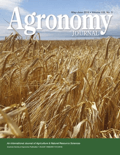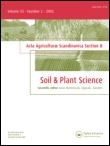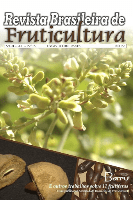
MAYDICA
Scope & Guideline
Advancing agricultural science through rigorous research.
Introduction
Aims and Scopes
- Genetic Diversity and Breeding:
Research focused on genetic variation within maize and sorghum species, including studies on inbred lines, hybrids, and local populations to enhance breeding programs. - Agronomic Practices and Crop Management:
Exploration of various agronomic interventions, including fertilization, irrigation, and planting methods to improve yield and quality of maize and sorghum. - Phenotypic and Molecular Characterization:
Characterization of morphological traits and molecular markers to understand genetic traits and their implications for crop improvement. - Stress Response and Resilience:
Studies examining the effects of environmental stresses such as drought, salinity, and pests on crop performance, aiming to develop resilient varieties. - Sustainable Agricultural Practices:
Research promoting ecological intensification, integrated nutrient management, and sustainable practices to enhance productivity while minimizing environmental impact.
Trending and Emerging
- Genomic and Molecular Approaches in Breeding:
An increasing number of studies are utilizing genomic tools and molecular markers to enhance breeding programs, indicating a trend towards precision agriculture and genomics. - Climate Resilience and Stress Tolerance:
Research focused on developing crop varieties that can withstand climate-related stresses, such as drought and salinity, has gained prominence, reflecting the urgent need for resilient food systems. - Integrated Nutrient Management and Sustainable Practices:
There is a growing emphasis on sustainable agricultural practices, particularly integrated nutrient management, as researchers seek to balance productivity with environmental stewardship. - Diversity Mapping and Geographic Information Systems (GIS):
The use of GIS and diversity indices to map genetic diversity and understand trait distributions is emerging as a key research area, allowing for better-targeted breeding efforts. - Application of Artificial Intelligence in Agronomy:
The incorporation of AI and machine learning techniques in agronomic research is gaining traction, enabling more sophisticated analyses and predictions in crop research.
Declining or Waning
- Traditional Pest Control Methods:
There has been a noticeable decrease in studies focused on conventional pest management strategies, as the journal's emphasis shifts toward integrated pest management and genetic resistance. - Basic Morphological Studies without Molecular Insights:
Research solely focused on basic morphological traits without molecular characterization is declining, as there is a growing trend toward molecular approaches that provide deeper insights into genetic traits. - Single-Dimensional Yield Studies:
Papers focusing exclusively on yield without considering other agronomic traits or environmental factors are becoming less frequent, indicating a shift toward more holistic approaches in research.
Similar Journals

AGRONOMY JOURNAL
Advancing Sustainable Agriculture Through Innovative ResearchThe Agronomy Journal, published by Wiley, is a leading platform for cutting-edge research in the field of agronomy and crop science. Established in the United States, this prestigious journal carries the ISSN 0002-1962 and E-ISSN 1435-0645, with its coverage spanning from 1976 to 2024, showcasing a wealth of knowledge over decades. The journal is recognized in the top quartile (Q1) of its category, making it a highly respected source for quality literature, ranking #108 out of 406 in the Scopus database and reflecting a 73rd percentile standing in agricultural and biological sciences. While it operates under traditional access options, its commitment to disseminating valuable scientific inquiry aligns with the objectives of advancing sustainable agricultural practices globally. The Agronomy Journal serves as an indispensable resource for researchers, professionals, and students eager to stay abreast of significant advancements and discussions influencing the future of crop science and agronomic research.

Czech Journal of Genetics and Plant Breeding
Connecting researchers to cultivate a greener tomorrow.Czech Journal of Genetics and Plant Breeding is a premier academic journal dedicated to advancing the fields of genetics and plant science. Published by the esteemed Czech Academy Agricultural Sciences, this journal has been available as an Open Access resource since 2002, ensuring that essential research is freely accessible to a global audience. With an ISSN of 1212-1975 and an E-ISSN of 1805-9325, it continues to disseminate high-quality studies and findings from the vibrant scientific community in the Czech Republic and beyond. The journal operates within the Scopus ranks, securing 279th place in the category of Plant Science and 282nd in Genetics, reflecting its commitment to scholarly rigor. The Journal's objectives focus on exploring innovations in genetic research and plant breeding methodologies, offering valuable insights that foster collaboration among researchers, professionals, and students alike. As the journal converges from 2007 to 2024, it remains a vital publication for those seeking to stay abreast of developments in genetic diversity, crop improvement, and sustainable agriculture practices.

Crop Journal
Advancing sustainable agriculture through innovative research.Crop Journal (ISSN: 2095-5421; E-ISSN: 2214-5141) is a premier, open access journal published by KEAI PUBLISHING LTD, dedicated to advancing the fields of agronomy and plant science. Established in 2013, this journal has quickly established itself as a vital resource for researchers, professionals, and students, achieving a remarkable Q1 ranking in both Agronomy and Crop Science, as well as Plant Science. With an impressive position in the Scopus rankings—30th out of 516 in Plant Science and 25th out of 406 in Agronomy—it stands at the forefront of scholarly discourse, representing the latest innovations and research breakthroughs within the global agricultural community. The journal embraces a broad scope that encompasses all aspects of crop science, aiming to foster understanding and propel advancements in sustainable agricultural practices. Accessible from anywhere in the world, Crop Journal plays a crucial role in disseminating knowledge that addresses the challenges of food security and environmental sustainability, making it an indispensable tool for those invested in the future of our planet's agriculture.

CANADIAN JOURNAL OF PLANT SCIENCE
Transforming Agricultural Insights into ActionCanadian Journal of Plant Science (ISSN: 0008-4220, E-ISSN: 1918-1833) is a prestigious publication dedicated to advancing research in the fields of agronomy, horticulture, and plant science. Published by Canadian Science Publishing, this journal has been a cornerstone in the Canadian and international scientific community since its inception in 1973. With a solid presence in reputable databases, it ranks in the Q3 category for multiple disciplines as of 2023, reflecting its impact and relevance within the agricultural sciences. The journal serves as a vital resource for researchers, professionals, and students, encouraging the dissemination of innovative findings and fostering collaboration across disciplines. Although it is not an open-access journal, subscribers gain exclusive access to a wealth of knowledge, with articles aiming to enhance the understanding of plant systems and contribute to sustainable agricultural practices. The Canadian Journal of Plant Science remains committed to supporting the growth of plant-related research and its practical applications in today's changing environmental landscape.

ACTA AGRICULTURAE SCANDINAVICA SECTION B-SOIL AND PLANT SCIENCE
Bridging Science and Practice in Agronomy and Soil ScienceACTA AGRICULTURAE SCANDINAVICA SECTION B-SOIL AND PLANT SCIENCE, published by Taylor & Francis AS, is a distinguished journal dedicated to the fields of Agronomy, Crop Science, and Soil Science. With an impressive impact factor, and categorized in Q2 for both Agronomy and Crop Science and Soil Science as of 2023, this journal is an essential resource for researchers, professionals, and students aiming to advance their understanding of soil-plant interactions and sustainable agricultural practices. Operating since 1992 and continuing through to 2024, ACTA aims to publish high-quality, peer-reviewed research that encourages the applicability of advanced scientific knowledge in real-world agricultural settings. While the journal is not open access, it remains widely accessible through institutional subscriptions, reflecting its commitment to disseminating essential findings and fostering innovation in soil and plant science worldwide. Nestled in the vibrant academic environment of Norway, ACTA AGRICULTURAE SCANDINAVICA serves as a key platform for nurturing groundbreaking research that informs sustainable agricultural policies and practices globally.

Revista Brasileira de Fruticultura
Pioneering Sustainable Practices in Fruit ResearchRevista Brasileira de Fruticultura, published by the Sociedade Brasileira de Fruticultura, is a leading scholarly journal dedicated to the advancement of research in the fields of agronomy, crop science, food science, horticulture, and plant science. With an impressive Open Access model adopted since 2001, the journal is committed to disseminating high-quality research from Brazil and beyond, promoting innovation and collaboration among researchers, professionals, and students alike. The journal currently holds a respectable Q3 category ranking in multiple fields as of 2023, reflecting its significance within the scientific community, specifically ranked #72 in horticulture and #257 in agronomy, among its peers. The Revista Brasileira de Fruticultura not only serves as a platform for original research articles, reviews, and case studies but also emphasizes practical applications and sustainable practices in fruit cultivation. Its aim is to enhance the visibility of Brazilian fruit research on a global scale, making it an invaluable resource for those invested in advancing horticultural sciences.

Philippine Journal of Crop Science
Bridging local expertise with global agricultural advancements.Philippine Journal of Crop Science is a leading scholarly publication dedicated to advancing the field of crop science in the Philippines and beyond. Published by the CROP SCIENCE SOCIETY OF THE PHILIPPINES, this journal serves as a vital platform for researchers, professionals, and students to disseminate original research, innovative techniques, and comprehensive reviews that address both local and global agricultural challenges. Although currently operating under a traditional access model, its commitment to enhancing agricultural productivity and sustainability underscores its relevance in the dynamic landscape of crop science. The journal’s emphasis on high-quality research contributes significantly to the academic dialogue surrounding crop improvement, pest management, and environmental conservation. By fostering collaboration and knowledge-sharing among the academic community, the Philippine Journal of Crop Science plays an essential role in driving scientific inquiry and informed decision-making in the agriculture sector.

Legume Research
Cultivating Knowledge for Sustainable Legume SolutionsLegume Research, published by the AGRICULTURAL RESEARCH COMMUNICATION CENTRE in India, is an essential peer-reviewed journal focusing on advancements in the field of agronomy, crop science, soil science, and plant science. With an ISSN of 0250-5371 and operating since 2008, this journal caters to researchers, agricultural professionals, and students interested in the critical role of legumes in sustainable agriculture and food security. It ranks within the third quartile (Q3) in several prominent categories, reflecting its contribution to the agricultural and biological sciences community—ranking #279 in Agronomy and Crop Science, #113 in Soil Science, and #376 in Plant Science based on Scopus metrics. Although not open access, Legume Research remains a vital resource for those seeking to enhance their knowledge and contribute novel research findings in the ever-evolving discipline of legume cultivation and utilization. With a clear objective to disseminate impactful research, this journal significantly contributes to the global understanding of legumes' ecological, economic, and nutritional importance.

Zemdirbyste-Agriculture
Fostering global discourse on food security and environmental health.Zemdirbyste-Agriculture is a prominent journal dedicated to advancing the field of agricultural sciences, with a particular focus on agronomy and crop science. Published by the Lithuanian Research Centre Agriculture & Forestry, this open access journal has been fostering knowledge sharing and scientific discourse since 2004, allowing researchers, professionals, and students unrestricted access to its content. Located in the beautiful country of Lithuania, specifically at Vytautas Magnus University, this journal plays a significant role in disseminating innovative research findings. With a 2023 Scopus ranking of #246 out of 406 in the category of Agricultural and Biological Sciences, Zemdirbyste-Agriculture falls within the Q3 quartile, reflecting its growing influence in the academic community. This journal, which has converged its publication focus from 2008 to 2023, aims to provide a platform for scientists to share their critical insights on agricultural practices, sustainability, and technological advancements in crop science, thereby contributing to the global discourse on food security and environmental health.

Plant Gene
Innovating Plant Science Through Genetic InsightsPlant Gene is an esteemed academic journal dedicated to the comprehensive study of plant genetics, genomics, and biotechnology. Published by Elsevier, this journal operates from its base in the Netherlands and has made significant strides since its inception in 2015, with a converged year span extending until 2024. As an integral resource in the field, Plant Gene is categorized in the Q2 quartile for Plant Science and Q3 for Biochemistry, Biotechnology, and Genetics as per the 2023 evaluations, reflecting its growing influence and quality of research. With an impactful presence in Scopus rankings—positioned at #145 in Plant Science—this journal serves as a platform for presenting innovative findings and advancing knowledge in plant science. Researchers, professionals, and students will find access to cutting-edge research articles that not only drive the scientific community forward but also offer invaluable insights into the genetic mechanisms underpinning plant development and resilience. While the journal currently operates under a subscription-based model, it aims to broaden accessibility and foster a diverse range of scholarly discussions in the ever-evolving field of plant genetics.